
Wonder Woman is a superheroine created by the American psychologist and writer William Moulton Marston, and artist Harry G. Peter in 1941 for DC Comics. Marston's wife, Elizabeth, and their life partner, Olive Byrne, are credited as being his inspiration for the character's appearance.
Fury is the codename shared by three DC Comics superheroes, two of whom are mother and daughter, both of whom are directly connected with the Furies of mythology, and the third who is an altogether different character.

The Cheetah is a supervillain appearing in DC Comics publications and related media, commonly as a major adversary of the superhero Wonder Woman. Like her nemesis, she was created by William Moulton Marston & H. G. Peter, debuting in the autumn of 1943 in Wonder Woman #6. With her distinctive sleek, spotted appearance, She has since endured as the archenemy of the superhero Wonder Woman. and has been a persistent foe throughout every era of the hero's comic book adventures.
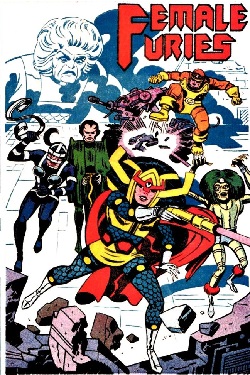
The Female Furies are a group of women warriors and supervillains appearing in comics published by DC Comics. All of them are New Gods who serve Darkseid. They operate directly under Granny Goodness, who trains all of Darkseid's soldiers.
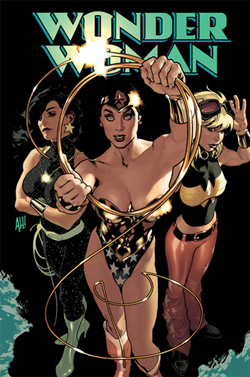
Wonder Girl is the alias of multiple superheroines featured in comic books published by DC Comics. Donna Troy, the original Wonder Girl, was created by Bob Haney and Bruno Premiani and first appeared in The Brave and the Bold #60. The second Wonder Girl, Cassie Sandsmark, was created by John Byrne and first appeared in Wonder Woman #105. Both are protégées of Wonder Woman and members of different incarnations of the Teen Titans. The alias has also been used in reference to a younger version of Wonder Woman as a teenager. In the 2020s, DC introduced a third Wonder Girl in Yara Flor, who hails from a Brazilian tribe of Amazons and was shown in a flashforward to one day succeed Diana as Wonder Woman.
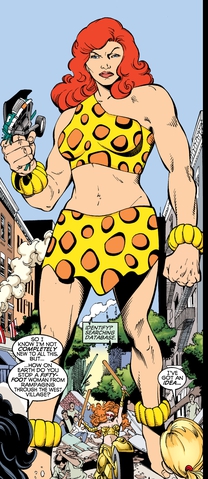
Giganta is a fictional character appearing in DC Comics publications and related media, commonly as a recurring adversary of the superhero Wonder Woman, and an occasional foil of the superhero the Atom. She debuted as a brutish strongwoman in 1944's Wonder Woman #9, written by Wonder Woman creator William Moulton Marston and illustrated by Harry G. Peter, and went on to become one of Wonder Woman's most recognizable and persistent foes, appearing during every major era of the hero's comic book adventures, and adapted frequently for television and animation.

DC: The New Frontier is an Eisner, Harvey, and Shuster Award-winning six-issue comic book limited series written and drawn by Darwyn Cooke, and published by DC Comics in 2004. The series was collected into two trade paperback volumes in 2004 and 2005, an Absolute Edition in 2006 and a deluxe edition in 2015. The story was adapted into an animated film, Justice League: The New Frontier, which was released on February 26, 2008.

Doctor Psycho is a fictional character appearing in DC Comics publications and related media, commonly as a recurring adversary of the superhero Wonder Woman. First appearing in Wonder Woman, issue #5 (1943), written by Wonder Woman creator William Moulton Marston, the character would become one of the Amazing Amazon's most persistent enemies, reappearing throughout the Golden, Silver, Bronze, and Modern Age of Comics.

Cassandra "Cassie" Sandsmark, also known as Wonder Girl, is a superheroine appearing in DC Comics. She was created by John Byrne and first appeared in Wonder Woman #105. The second Wonder Girl, Cassie is a sidekick of the superheroine Wonder Woman and has been featured as a member of the Teen Titans.

The Invisible Plane is a plane appearing in DC Comics, commonly used by Wonder Woman as a mode of transport. It was created by William Moulton Marston and first appeared in Sensation Comics #1.

Ares is a god and supervillain appearing in DC Comics publications and related media. Based on the eponymous Greek mythological figure, he is the Olympian god of war and major recurring adversary of the superhero Wonder Woman. He has been featured significantly as a persistent foe throughout every era of Wonder Woman's comic book adventures, and in many adaptations of her stories in other media.
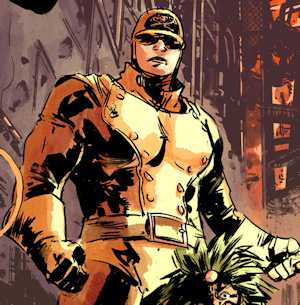
Stompa is a supervillain and goddess appearing in books published by DC Comics. Created by writer/artist Jack Kirby, the character first appeared in Mister Miracle #6.

Circe is a supervillain appearing in DC Comics publications and related media. Based upon the eponymous Greek mythological figure who imprisoned Odysseus in Homer's Odyssey, she is a wicked sorceress and major recurring adversary of the superhero Wonder Woman. She has been presented variously since first appearing in 1949’s Wonder Woman #37, though her characterization has consistently retained a key set of features: immortality, stunning physical beauty, a powerful command over sorcery, a penchant for turning human beings into animals and often, a delight in humiliation.

Nubia is a fictional character appearing in DC Comics publications and related media, commonly as an ally of Wonder Woman. Historically, she is DC Comics' first black female superhero. Originally introduced in 1973 as Diana's long-lost black fraternal twin sister, today the character is depicted as one of Wonder Woman's oldest and closest friends. Created by Robert Kanigher and Don Heck, Nubia debuted in 1973's Wonder Woman #204 and appeared intermittently throughout Wonder Woman's Bronze Age adventures.

Hercules is a fictional Olympian god in the DC Universe based on the Greek demigod and hero of the same name.
Queen Desira is a fictional character who appeared in many Golden Age adventures with Wonder Woman. She is the queen of the planet Venus, and would often seek help from Wonder Woman to defend her planet. Desira empowered Wonder Woman with magnetic hearing, which allowed the queen to transmit messages through Wonder Woman's earrings.
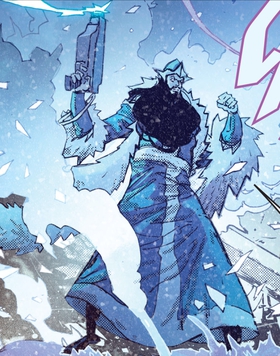
Minister Blizzard is a fictional character appearing in DC Comics publications and related media, commonly as a recurring adversary of the superhero Wonder Woman. A would-be world conqueror from a hidden Arctic civilization, he debuted in 1948 in Wonder Woman #29, written by an uncredited Joye Hummel Murchison and illustrated by Harry G. Peter. One of two members of Wonder Woman's rogues gallery introduced in the 1940s to have an ice/snow motif, Minister Blizzard, was an early progenitor of the comics trope of the ice-gun wielding supercriminal, preceding more recognizable DC Comics antagonists such as Mr. Freeze and Captain Cold, as well as Marvel Comics' Blizzard.

The Children of Ares are several fictional characters appearing in DC Comics publications and related media, commonly as recurring adversaries of the superhero Wonder Woman. Primarily based on eponymous Greek mythological figures, they are malevolent progeny of Wonder Woman's nemesis, the war god Ares. Three in particular – Deimos, Phobos and Eris – have emerged as especially enduring characters, appearing in every era of Wonder Woman's comic book adventures since debuting in 1969's Wonder Woman #183. Beginning in the Silver Age of Comic Books, these three characters have often been presented as Ares’ principal legates in his campaigns for universal conquest, and have also confronted Wonder Woman on their own, individually as well as with one another, as antagonists independent of their father.
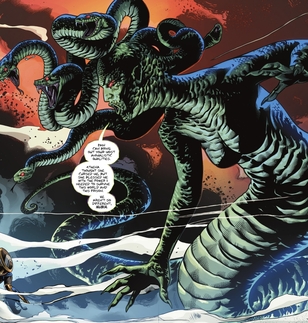
Medusa is a supervillain appearing in DC Comics publications and related media, commonly as a recurring adversary of the superhero Wonder Woman. Based upon the eponymous Greek mythological figure whose story was chronicled in Ovid's Metamorphoses, she is a snake-haired Gorgon with the ability to turn living creatures to stone with her gaze. Since her debut in 1964, Medusa's physical appearance has been presented variously as DC Comics' continuities have shifted and evolved. Though she has routinely been depicted with snakes for hair, she has sometimes been shown as bipedal and sometimes with a serpentine lower body. However across continuities, she has consistently been written with the ghostly ability to possess or influence other beings after her physical body has been killed, as well as an uncanny capacity for resurrection after death. Her characterization has been that of a dangerous immortal creature who is at turns both vengeful and sympathetic.
The Legend of Wonder Woman is a series starring Wonder Woman, published by DC Comics. The series was created by Renae De Liz, with colors, inks, and letters by her husband, Ray Dillon. It functions as a modern retelling of Wonder Woman's Golden Age origin, with heavy influence from the original comics by William Moulton Marston. The series was nominated for the Eisner Award for Best Digital/Webcomic.
























